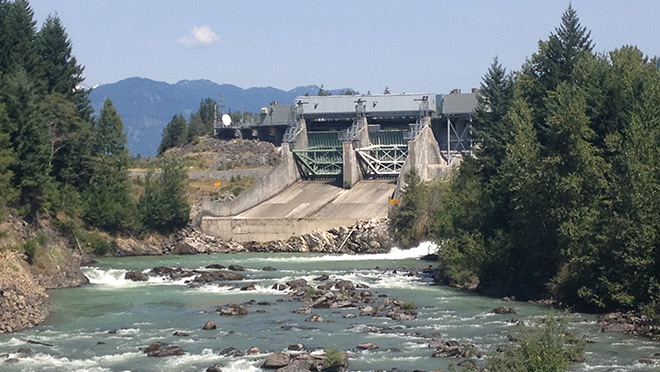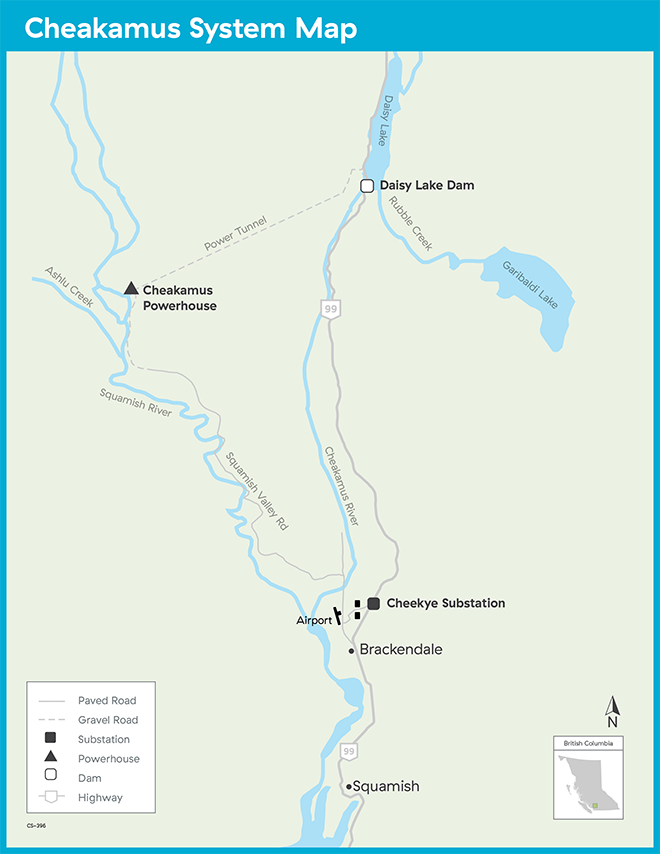Cheakamus system

What's new
September 2025
Pink salmon return to the Cheakamus River
Every odd-numbered year, pink salmon return to the Cheakamus River – and this year, they're back in what's estimated to be a historically large pink salmon run.
We're again implementing our Pink Salmon Response Strategy, working closely with the Squamish Nation to monitor the salmon run and protect fish throughout their migration and spawning journey.
What we're doing: Salmon monitoring and protection
From August 18 to October 15, we're conducting weekly in-river assessments to:
- Monitor river conditions and pink salmon spawning status.
- Identify critical spawning habitats to reduce fish stranding.
- Ensure mitigation readiness and determine crew requirements.
Key actions from the pink salmon plan
- Weekly surveys to monitor the status of pink salmon spawning and spot stranding risks.
- Extra crews and rafts during peak monitoring and salvage times (up to 20 qualified personnel available).
- Collaboration with Squamish Nation, working together to monitor and salvage fish.
- Gradual flow reductions (baseflow ramp downs) to give fish and crews more time to adjust.
- Storm ramp downs that mimic natural river changes after heavy rain.
Our operations on the Cheakamus manage multiple objectives: dam safety, flood mitigation (public safety), fish and the environment, as well as recreational use.
About baseflow ramp downs
Each August, we gradually lower river flows as summer runoff slows down. This helps protect fish habitat while keeping enough water flowing through late summer and early fall.
This year's baseflow ramp down successfully completed on August 29, 2025. The ramp down proceeded as planned following the recommended ramp rates. Fish salvage was performed and low levels of fish stranding were observed, consistent with the results from previous ramp down monitoring.
Stay informed
- Check real-time river flow data at Brackendale.
- Read about pink salmon runs.
- Watch videos on Instagram, LinkedIn, X, Facebook, and YouTube showing our pink salmon response plan in action.

Daisy Lake Dam impounds water flowing south from the headwaters of the Cheakamus River in Daisy Lake Reservoir for diversion through a tunnel that runs through Cloudburst Mountain to the Cheakamus Generating Station on the Squamish River. Water is released from the dam down a 26 kilometre stretch of Cheakamus River to its confluence with the Squamish River.
We work to upgrade and maintain existing assets like the facilities in the Cheakamus system so that our customers continue to receive reliable and clean electricity. There are currently a number of projects in the system including work at Daisy Lake Reservoir, penstocks and the Generating Station. Projects include:
- Replacement of turbine inlet valves – complete.
- Units 1 and 2 generator replacement – complete.
- Penstock recoating – The painting scope will be complete by the end of 2025, but demobilization may continue for a few months after that.
- Penstock detection installation – Upcoming.
The Water Use Plan (WUP) for the Cheakamus facility was completed in 2003 and was developed through a multi-year consultative process.
Refer to the Cheakamus Water Use Plan page to:
- Review the Water Use Plan and the Water Use Plan Order Review.
- Learn about the latest updates and what's coming next.
- Access relevant reports, presentations and more.
Following observations of higher than anticipated numbers of stranded juvenile salmon in August 2018, we committed to implementing the Cheakamus Adaptive Stranding Protocol (CASP) to study the effects of flow reductions on the Cheakamus River, and implement recommendations to mitigate impacts.
The study's objectives include:
- To better understand the risk of fish stranding on the Lower Cheakamus River,
- To test the effectiveness of different mitigation measures during those types of operations that may strand fish, and
- To identify effective fish stranding mitigation options for consideration for long-term implementation.
Since the implementation of the CASP in fall 2018, we've deployed fish monitoring crews on the Cheakamus River during planned flow reductions.
Read the CASP Year 1 Study [PDF, 4.3 MB].
Read the interim report.
The Fish and Wildlife Compensation Program (FWCP) is a partnership between BC Hydro, the Government of B.C., Fisheries and Oceans Canada, First Nations, and public stakeholders to conserve and enhance fish and wildlife impacted by the footprint of existing BC Hydro dams.
Since 1999 more than $3M has been spent on 41 projects in the Cheakamus River Watershed. This includes 30 projects related to fish.
Additional information about the FWCP
The FWCP is funded by BC Hydro and compensates for the historical impacts to fish, wildlife and their supporting habitats affected by generation facilities. In the past five years, the program has invested $1.1M in habitat-enhancing projects in the Cheakamus River Watershed.
Get in touch
If you'd like to learn more about the project, please contact us at:
Email: projects@bchydro.com
Phone: 604 623 4472
Toll free: 1 866 647 3334